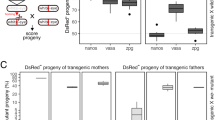Abstract
Before the Sterile Insect Technique can be applied successfully, the size of the target population has to be reduced to a manageable level. At present this reduction is achieved by the use of insecticides. Computer simulations have been performed to examine the possibility of achieving this initial population suppression by genetic control strategies; in particular, the effect of releasing fertile males carrying a recessive temperature-sensitive lethal mutation and a Y-autosome translocation has been simulated. The results show that the release of such males is most effective when applied under permissive conditions, i.e. those which allow flies homozygous for the temperature-sensitive lethal mutation to survive and spread the mutation through the population. However, combining this population replacement with a population-suppression strategy is even more effective. If the released males are partially sterile, e.g. due to the presence of a Y-autosome translocation, the population size is reduced before the restrictive conditions for the temperature-sensitive lethal mutation are reached, i.e. before the increase of temperatures in the target area eliminates all flies homozygous for this mutation. By combining these two strategies the resulting population should be low enough to apply the Sterile Insect Technique for eradication.
Similar content being viewed by others
References
Carpenter JE (1991) Comparative response to radiation of the T:Y(wp+)30C genetic sexing strain and a wild-type strain of the Mediterranean fruit fly (Diptera: Tephritidae). J Econ Entomol 84:1705–1709
Curtis CF (1968) Possible use of translocations to fix desirable genes in insect pest populations. Nature 218:368–369
Curtis CF, Hill WG (1971) Theoretical studies on the use of translocations for the control of Tsetse flies and other disease vectors. Theor Pop Biol2:71–90
Curtis CF, Robinson AS (1971) Computer simulation of the use of double translocations for pest control. Genetics 69:97–113
Fitz-Earle M, Suzuki DT (1975) Conditional mutations for the control of insect populations. In: IAEA (ed) Sterility principle for insect control. IAEA, Vienna, Austria, STI/PUB/ 377:365–374
Fitz-Earle M, Holm DG, Suzuki DT (1975) Population control of caged native fruitflies in the field by compound autosomes and temperature-sensitive mutants. Theor Appl Genet 46:25–32
Foster GG (1992) Simulation of genetic control. Homozygous-viable pericentric inversions in field-female killing systems. Theor Appl Genet 82:368–378
Foster GG, Smith PH (1991) Genetic control of Lucilia cuprina:analysis of field trial data using simulation techniques. Theor Appl Genet 82:33–43
Foster GG, Whitten MI, Prout T, Gill R (1972) Chromosome rearrangements for the control of insect pests. Science 176:875–880
Foster GG, Vogt WG, Woodburn TL, Smith PH (1988) Computer simulation of genetic control. Comparison of sterile males and field-female killing systems. Theor Appl Genet 76:870–879
Franz G, Kerremans Ph (1993) Radiation-induced chromosome aberrations for the genetic analysis and manipulation of the Mediterranean fruit fly, Ceratitis capitata. In: IAEA (ed) Management of insect pest: Nuclear and related molecular and genetic techniques. IAEA, Vienna, Austria, STI/PUB/ 909:187–194
Franz G, Gencheva E, Kerremans Ph (1994) Improved stability of genetic sex-separation strains for the Mediterranean fruit fly, Ceratitis capitata. Genome 37:72–82
remans Ph, Franz G (1994) Cytogenetic analysis of chromosome 5 from the Mediterranean fruit fly, Ceratitis capitata. Chromosoma 103:142–146
Kerreassen W, Creech JF (1973) Population suppression with dominant and conditional lethal mutations: some important considerations and approaches. In: IAEA (ed) Computer models and application of the sterile-male technique. IAEA, Vienna, Austria, STI/PUB/ 340:65–79
Klassen W, Lindquist DA, Buyckx EJ (1994) Overview of the Joint FAO/IAEA Division's involvement in fruit fly sterile insect technique programmes. In: Calkins CO, Klassen W, Liedo P (eds) Fruit flies and the sterile insect technique. CRC Press, Boca Raton, Florida, USA, pp 3–26
LaChance L, Knipling E (1962) Control of insects through genetic manipulations. Entomol Soc Am Ann 55:515–520
Robinson AS (1976) Progress in the use of chromosomal translocations for the control of insect pests. Biol Rev 51:1–24
Robinson AS (1977) Translocations and balanced polymorphism in a Drosophila melanogaster. Genetica 47:231–236
Whitten MJ (1971) Use of chromosome rearrangements for mosquito control. In: IAEA (ed) Sterility principle for insect control or eradication. IAEA, Vienna, Austria, STI/PUB/265:399–413
Whitten MJ, Foster GG, Vogt WG, Kitching RL, Woodburn TL, Konovalov C (1977) Current status of genetic control of the Australian sheep blowfly, Lucilia cuprina (Wiedemann) (Diptera: Calliphoridae). In: Proc XV Int Congr Entomol. Washington, D.C., pp 129–139
Author information
Authors and Affiliations
Additional information
Communicated by G. Wenzel
Rights and permissions
About this article
Cite this article
Kerremans, P., Franz, G. Use of a temperature-sensitive lethal mutation strain of medfly (Ceratitis capitata) for the suppression of pest populations. Theoret. Appl. Genetics 90, 511–518 (1995). https://doi.org/10.1007/BF00221997
Received:
Accepted:
Issue Date:
DOI: https://doi.org/10.1007/BF00221997




